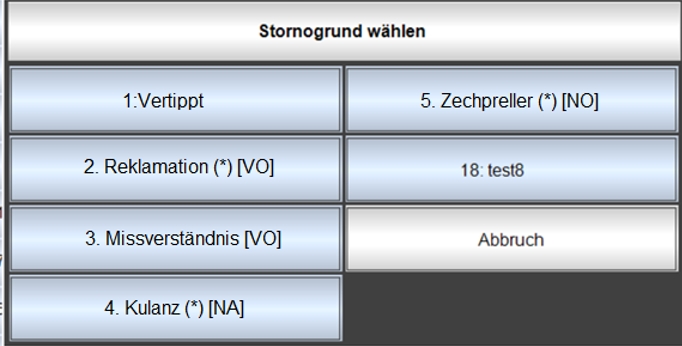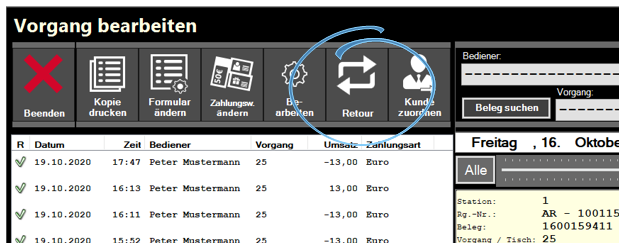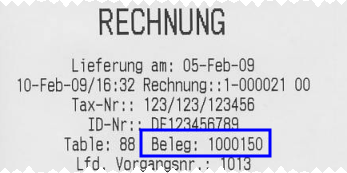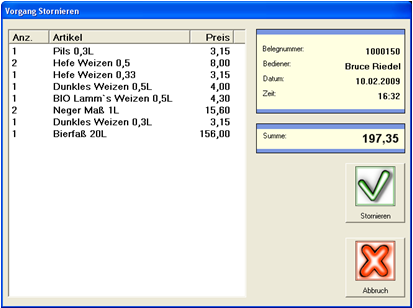Cancellation bookings in practice
The hierarchy of cancellations
- Pre-order cancellation allows the operator to create counter-entries for entries that have not been closed by New Balance or any other command and for which no order slip has yet been printed. The posting and the offsetting entry are hidden.
- The reversal by order generates offsetting entries for postings that have already been communicated to the production points after the new balance. These counter entries are stored visibly for the operator, so he can make sure that he has carried them out.
- When reversing returns, you create "offsetting entries" without checking the existence of an original posting. Return cancellations can be posted to in any transaction. You can therefore post a return without being in the transaction with the original posting.
- In an adjustment reversal, you also create "offsetting entries" without checking the existence of an original posting. Press the Correction Cancel button if no operation is open, because an extra operation is opened. In addition, you will be asked for which operator you want to cancel. Correction cancellations are therefore for the case that operators have not previously canceled and that the cancellations are posted after a reconciliation. This type of controlling works, but leads to less traceability of the booking data and does not comply with the German GoBD regulations when it comes to booking as promptly as possible.
- You can use Edit activity to reopen completed activities until day-end closing. For each posting contained in the transaction, an offsetting entry is created (if the transaction was closed by invoice, a reversal document is created) and a new transaction with the former postings is opened at the same time. With this method, the postings receive the status Reopen. The operator can add new bookings or remove existing ones. You can use an authorization setting Reversal after closing to determine whether postings with the status Reopen can be reversed. In addition, there are authorizations to transfer or split Reopen postings. With the authorization for cancellation after completion, the operator can use cancellation after order (since no further function is required). Further documentation: Monitor reversal after completion
- With the global ward setting Change operations after daily closing, you can also use the Edit operation function for operations before the last daily closing. Offsetting entries are created, but the reports can therefore change.
Further documentation: Hypersoft procedure for cancellations
Differentiate cancellations with queries
Depending on your business situation, we recommend that you allow operators to cancel post-order bookings so that they can cancel post-order bookings without having to call in a senior executive. If possible, also give authorization for cancellation after completion - possibly for a restricted group of users.
If you apply this correctly, it can make your work much easier without increasing risks.
Later, you can discuss the cancellations with the operators using the reports. For this procedure it is useful to use the Cancellation reason query function. Cancellation reasons store additional information and enable the targeted interface with losses in order to differentiate cancellation losses from informative cancellations. Example: Cancellation reason "Guest has changed his mind" does not need to be checked further. The reason for the cancellation "wine was corked" should be traceable somewhere by a returned wine.
Once everything is set up, only a small part, namely cancellations with loss of goods, has to be checked. Here is an example of the query:

If a reversal list contains different booking types (for example, cancellations after order and cancellations after completion in a reopened activity), all the reversal reasons for all the bookings contained are displayed. If cancellation reasons are only intended for one booking type, this reason is countersigned in each case:
[VO] = Cancellation before order
NO] = Cancellation after order
NA]= Cancellation after completion
(*) = a reason for loss is assigned to the cancellation reason.
Here cancellation reason 2,3 are defined exclude for cancellation before order, 4 for cancellation after completion and 5 for cancellation after order, 1 for all.
If there is only one active cancellation reason, this is selected automatically.
Since the reasons for cancellation also stand on the order vouchers, every employee who works with order vouchers should also be clear about the connections. Just when a reason appears that the item could not be sold, a responsibility within the team can be represented here.
Each cancellation (regardless of category) that is without a query or with a query without an assigned reason for loss posts the position again. Whenever you assume that the goods / item cannot be returned to sale with the cancellation, select a cancellation reason with loss.
You can switch off and on the query for certain operators in the operator authorization.
Cash register function Cancellation before order
Cancels the postings of the current entry, i.e. before receipts were printed or New balance was activated. The cancellation before order always starts with the last posting and continues from there to the first posting when the transaction was opened. If postings already existed, a dashed line is displayed between these and the new postings. If you cancel before an order, no receipts are created.
Cancellations before order are not shown on the customer display.
Cash register function cancellation before order list
Same function as cancellation before order, but the items are displayed in a list for selection so that you cannot only cancel the last entry.
Cash register function Cancellation after order
Cancellation by order enables you to cancel postings according to the order receipt (New balance). Appropriate cancellation vouchers are issued for order receipts. Each cancellation will be shown in detail on the operator report.
A cancellation after order is automatically converted into a cancellation before order if:
- the reversals are made before the new balance or completion of the transaction,
- no order receipt has been printed yet,
- The operator has authorization for a cancellation before an order.
Cancellation after completion
The cancellation after completion is not a function the others. It's one permission, in fact it's two permissions. You need the authorization to reopen an operation and an authorization for cancellation after completion.
There is an extra chapter for this topic: Monitor reversal after completion
Cash register function Correction cancellation
This function allows you to perform subsequent cancellations. The function is called when no process is open. If the registered operator also has manager status, he or she can also cancel for other operators. A list of active operators is displayed for selection. The selection determines for whom a correction reversal is booked, otherwise the operator books for himself. For cancellation, a transaction is opened (fixed transaction number 1999999) that can accommodate the cancellation. To end your cancellations, press a closing key, for example BAR.
Important to correction-voids....
This type of reversal does not check for plausibility and generates reversal postings (negative postings) even if there are no positive postings (in the transaction) for this.
You can assign loss reasons to a correction cancellation by using the assignment of cancellation reasons including transfer to losses. However, the assigned reasons for cancellation are not evaluated in this particular case, only the losses. The correction cancellation is used as the cancellation reason.
If the item is kept in stock, the stock is added back to positive through the adjustment entries.
Further documentation:
Authorisation correction reversal...
Correction reversal from a fiscal perspective
Cash register function Retourstorno
In the case of a return reversal (as in the case of a correction reversal), no check is made as to whether there is a corresponding positive entry in the transaction. However, this function can only be used within any open process. This function is used, for example, by managers to make credit postings without having to find the original transaction. With return, the booking is made for the operator who executes the return booking. You can assign loss reasons to a return cancellation by using the assignment of cancellation reasons including transfer to losses. The Return Cancellation function asks for a reason for return.
If the item is kept in stock, the stock is positively replenished by the return entry.
The use of the return function in combination with an interim payment is prevented.
Return bookings with vouchers...
In many cases, the return cancellation is only used for vouchers. For this, the operators can be given the authorisation Return Cancellation or Return Cancellation with the restriction only vouchers.
Further documentation:
This function requires the operator authorisation Return Reversal.
See the details in the section Cancellations with integrated eSolutions.
Best practice cancellations from 3rd party or shop systems
If transactions are transferred from other systems to the POS system and may even have already been paid, we recommend using the function Transaction return. This handling may therefore be necessary, for example, if a customer has ordered something "online" twice or you cannot deliver the order in full.
With the transaction return you can, for example, cancel items from an order transaction and then complete it with any payment method. This way you can pay someone who has "paid too much" in a webshop, for example, the amount of the cancelled items. The negative sum can be taken from the cash turnover. Depending on which other payment systems you have connected and how they support this, you can also pay back on credit cards, for example, by completing the transaction with the negative amount without cash. This also applies to Hypersoft card systems, but not to the web voucher the latter must be topped up and do not accept negative payment).
If you use Hypersoft Pay powered by Adyen with eSolutions and in the POS area, you have cashless payments and returns in one system.
Process return
The transaction return variant is called up via the cash register function Edit transaction or Transactions: Return (below).

If an operation is selected and Return is pressed, the operation return is initiated. The bookings are available for your arbitrary selection:

The items to be returned can be transferred from the left list to the right list. By activating the green tick, the bookings are executed and a selection of the cancellation reasons is offered beforehand.
After selection, the transaction is now available as an ordinary transaction and must be completed with a payment method. No further bookings can be added at this point.
Variant Operations Return...
The same function, but initiated from a different programme. The call is made via the checkout function Operations: Retour.

You also select an operation here and proceed as described above.
Cancellation warning Customer display
There is a risk at locations where customers pay the amounts indicated on the customer advertisement (optional accessories) and not on the basis of an invoice. Here it can happen that after all bookings have been made, the operator collects only the balance instead of the close key and then deletes all bookings before closing the transaction with cancellation. Check the cancellation evaluations for such working environments.
Even more dangerous, however, is the saving of a customer advertisement, because then the customers pay on the call of the operator.
Cancellation Authorizations
In the operator authorisations you can define which of the cancellation functions are accessible to operators, this assignment is best done via roles or templates.
Other cancellations during transfer
For example, if the entire transaction is transferred, the reversals and the original postings remain in the source transaction. This is also correct, since the postings and reversals were made in this transaction.
Cancellations before orders and their postings are not visible in transactions, so that a source transaction containing only these postings is automatically closed.
Other cancellations result in the source operation being retained. This can be reworked and must also be completed. The minimum requirement is to open the source operation with the remaining cancellations and close it with BAR.
You can use this function to subsequently cancel a transaction using the document number. The transaction must be from the current billing period and the day-end closing (Z report) must not yet have been executed.
Enter the document number and choose Canceltransaction subsequently.

You are given the option of checking the transaction by displaying a dialog box with the postings for the transaction.

Press the Cancel button to confirm the process. In the booking journal, an identical entry is then entered with -1 as the number for each item. The Cancellation reason option is not triggered with this function.
The form number 19 is printed as a receipt (the same one used for voucher receipts). If the transaction was completed with a form with the setting Invoice, a credit memo is created.
Such cancellations are displayed in the user settlement as transaction cancellations.
Further documentation:
Authorizations for operation handling
Editing Cancellations and Operations
Effects of cancellations on order receipts
If an order receipt has been created for an item, a cancellation receipt is also printed in the same place in the event of a cancellation. However, this does not happen if the order receipt has not yet been printed, which is the case with immediate cancellation or is possible when using the Delayed receipt function. If the order receipt has not yet been printed at the time of the reversal, the system first tries to post the reversal as an immediate reversal, provided the user has the authorization Immediate reversal. If the operator does not do this, a positive and a negative entry are output simultaneously.
The order vouchers can still be specially set to display cancellations.
- You can make cancellations clearer by activating the cancellation indicator in the receipt.
- If you do not want to print an order receipt, but wish to receive a cancellation receipt in the event of a cancellation, you can activate the Cancellation receipt only option.
Cancellation representations depend on the printers used. All cancellations receive a negative sign. The display of the cancellations also depends on the type of printer:
| type | visualization |
|
When using a two-colour ribbon, cancellations are printed in the second colour |
|
|
Cancellations are displayed inverted |
|
|
Cancellations are displayed inverted |
A backoffice cancellation can be made in the master operation overview. The backoffice cancellation must be made accessible to the user as an authorization.
The reversal is written to the posting journal as type Backoffice reversal. No goods movements are linked to this and there are no cancellation reasons.
The backoffice cancellation receives the same time and date as the underlying booking. The reversal is therefore evaluated in the reports in the time period of the posting.
The operation of the Backoffice Cancellation with the Posting List function is described in the master transaction overview.
Please note that back office cancellations can also change hospitality receipts.
Also note that you can use Backoffice voids to change financial reports and all other reports. These changes are conclusively traceable in the reporting system and the cancellations are shown in the back office reports.
Pay particular attention to compliance with laws and regulations when you apply the back-office cancellation in time periods for which you have already generated reports or even settled taxes. If you have any questions in this regard, consult your tax advisor.
Further documentation:
Posting list of the master transaction overview
 Immediate cancellation (now cancellation before order)
Immediate cancellation (now cancellation before order)
Further documentation: